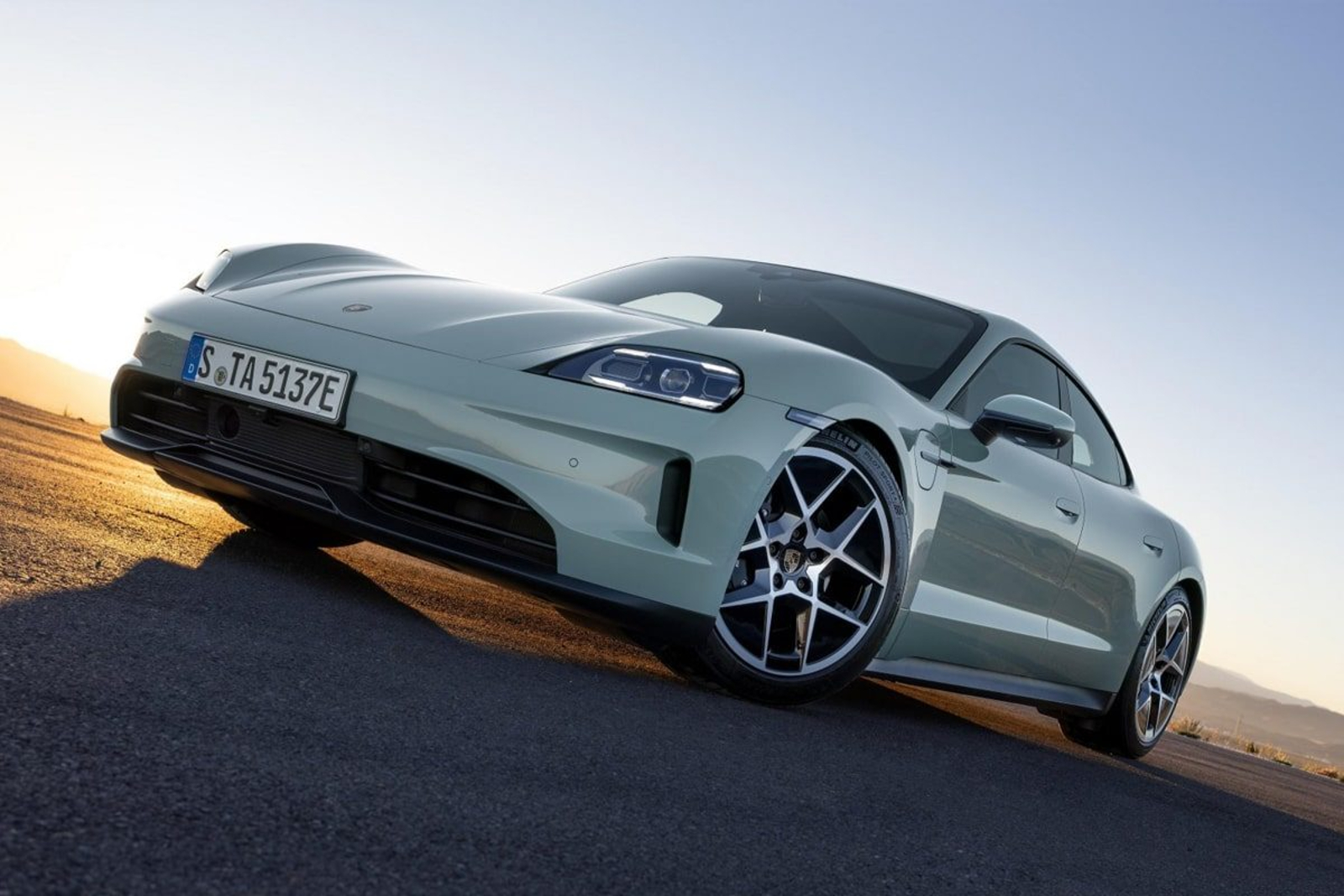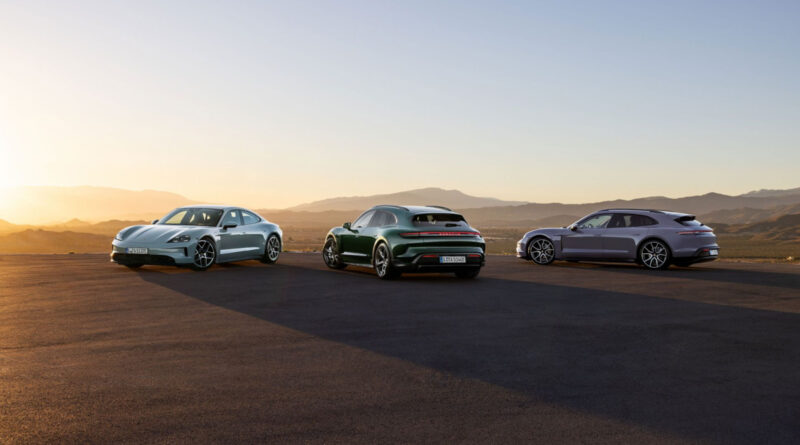Porsche Taycan 2.0 — Faster, Further, Focused
When the Porsche Taycan arrived 5 years ago, it was one of the first electric cars that could be called “compelling.” Now the second generation of the Taycan will go on sale this spring. The new car is the same but different in important ways. It’s still a four door sport sedan, except now it has smoother styling, bigger batteries, more range, and faster charging even in cold weather. Porsche has learned a lot about building electric cars in the past 5 years and all those lessons have been incorporated into the new Taycan.
“We ushered in the new era of e-mobility with the Taycan at the end of 2019. It immediately proved to be a game changer and innovative pioneer in the e-vehicle segment,” says Kevin Giek, head the Taycan team. “We are now continuing this success story with the extensively updated Taycan. The model line has reached new heights in terms of performance, with exceptional driving dynamics and driving pleasure. At the same time, we were able to significantly improve efficiency, range, day to day usability and comfort.”

Here’s a graphic that highlights all the major improvements:
| Taycan | Taycan 4S | Taycan Turbo | Taycan Turbo S | |
|---|---|---|---|---|
| Drive | RWD | AWD | AWD | AWD |
| Power | 300 kW | 340 kW | 520 kW | 570 kW |
| Overboost | 300 kW | 400 kW | 650 kW | 700 kW |
| Torque | 410 Nm | 695 Nm | 940 Nm | 1.110 Nm |
| Acceleration | 4,8 s | 3,7 s | 2,7 s | 2,4 s |
| Top speed | 230 kph | 250 kph | 260 kph | 260 kph |
| WLTP range | 678 km | 642 km | 678 km | 630 km |
| Battery capacity | 89 kWh | 89 kWh | 105 kWh | 105 kWh |
| Charging capacity DC | 270 kW | 270 kW | 320 kW | 320 kW |
| Charging time DC 10-80% | 18 min | 18 min | 18 min | 18 min |
| Price | 101,500 Euro | 120,900 Euro | 175,600 Euro | 209,900 Euro |
According to a Porsche press release, the new car has up to 35 percent more range, depending on what trim level is selected. That translates to an extra 175 km before the driver needs to stop to recharge. That increase is due to more than slightly larger batteries. The efficiency of the powertrain has also been improved. Porsche cites a modified pulse inverter with optimized software, a revised thermal management system, a next generation heat pump, modified regenerative braking, and a new all wheel drive strategy.
The maximum regeneration power during deceleration from high speeds has been increased by more than 30 per cent from 290 to up to a stellar 400 kW. A new “push to pass” function in the Sport Chrono package provides a power boost of up to 70 kW for a maximum of ten seconds.
Taycan Focused On Charging
Porsche has put a lot of effort into improving the charging experience for Taycan drivers. On the path to series production, development engineers and test drivers in camouflaged test cars covered more than 3.6 million kilometres around the world to keep improving the first all electric sports car from Porsche. Almost 150,000 Taycan cars have been produced. The most important individual markets for the Taycan are currently the US, the UK, Germany and China.
The improvements are many. Porsche says the peak charging power at 800 volt charging points has been increased by 50 kW to 320 kW. This is not just a short-term peak output: the charging power can exceed 300 kW for up to five minutes.
Another focus during the development of the new Taycan was on improving charging performance at lower temperatures. Although the Taycan automatically preheated the battery to the optimum temperature range when planning a route with a charging stop before, there was not always enough time to warm up the battery sufficiently during a short journey to the charging station or in the case of an unplanned charging stop.
With the original Taycan, charging from ten to 80 percent required 37 minutes at a battery temperature of 15 degrees C or 22.5 minutes under ideal conditions. Even though it has a larger battery, the new Taycan only needs 18 minutes to charge from 10 to 80 percent even when the battery is at 15 degrees C. There has been a lot of chatter lately about electric cars having trouble charging in the cold. Porsche has done something about that problem in the new version of the Taycan.
Standard And Not So Standard Equipment

Adaptive air suspension is now standard on all models of the Taycan. Porsche Active Ride suspension, which Porsche says offers “a previously unrivaled range between ride comfort and driving dynamics,” can be ordered as an option on all wheel drive versions. The company says the suspension upgrade keeps the body of the Taycan level at all times, even during dynamic braking, steering and acceleration maneuvers.
“With a smooth ride, the system absorbs bumps almost completely. In dynamic driving situations, the Porsche Active Ride suspension ensures an almost perfect connection to the road thanks to a balanced distribution of wheel loads. If the appropriate mode is activated, the suspension can compensate for pitching and rolling motions in order to reduce the acceleration forces acting on the occupants.”
Standard equipment now includes ambient lighting, ParkAssist with back up camera, electrically folding exterior mirrors with mirror surround lighting, heated front seats, Porsche Intelligent Range Manager, a heat pump with new cooling concept, smartphone tray for wireless charging, electric charging flap on the driver and passenger side, Drive Mode switch and Power Steering Plus. Despite the added equipment, the overall weight of the car has been reduced by 15 kg.
Inside, the instrument cluster, central display, and optional front passenger display have an optimized user interface with additional functions. Apple CarPlay has now been integrated deeper into the vehicle displays and functions. The new In-Car Video function enables video streaming on the central display and the front passenger display.
New headlights feature high resolution HD matrix technology with detailed optics and display the characteristic Porsche four point graphics at night. The Porsche logo in the rear light strip features a three dimensional, glass look design. An illuminated version of this is available for the first time, featuring welcome/leaving animations.
The Takeaway

Porsche builds cars that excite the senses. Now with the second generation Taycan, the company has taken what was a very good car and made it great. Everything the company has learned will be incorporated into other electric cars from Porsche, starting with the all electric Porsche Macan that is expected to enter production soon. While there are some storm clouds on the horizon for many electric cars, Porsche caters to a specialized clientele and is seeing no slackening in demand for the Taycan. For those who can afford the price of admission, the new and improved Taycan should behe very essence of a compelling electric car.
Have a tip for CleanTechnica? Want to advertise? Want to suggest a guest for our CleanTech Talk podcast? Contact us here.
Latest CleanTechnica.TV Video

CleanTechnica uses affiliate links. See our policy here.

